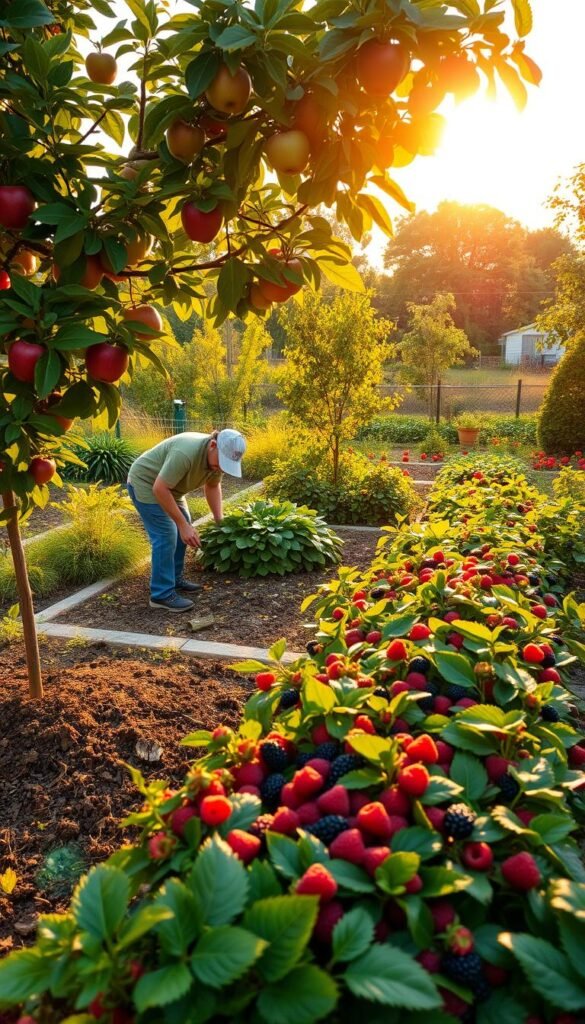Growing your own fresh produce is one of life’s sweetest joys. Imagine plucking sun-warmed berries or crisp figs steps from your door—these plants offer beauty and bounty with thoughtful planning. Blueberries, blackberries, and fig trees thrive when you sync care routines with nature’s calendar, working smarter—not harder.
Plants have their own seasonal playbook. In winter, they channel energy into root growth, building strength below ground. Come spring, leaves and blossoms take center stage. By summer, you’ll see juicy rewards. This rhythm lets you anticipate needs instead of reacting, saving time while boosting harvests.
Modern tools like greenhouse gardening setups stretch growing seasons without sky-high costs. Pair these with simple strategies: mulch in fall, prune in dormancy, protect buds from late frosts. Your garden becomes a four-act production, each season setting the stage for the next.
Whether you’re nurturing a patio container or backyard orchard, this guide unlocks year-round success. You’ll learn how to mirror natural cycles, adapt to your climate, and enjoy homegrown treats even when snow falls. Let’s dig into the seasonal shifts that make fruit-growing effortless and endlessly rewarding.
Getting Started: Planning Your Home Fruit Garden
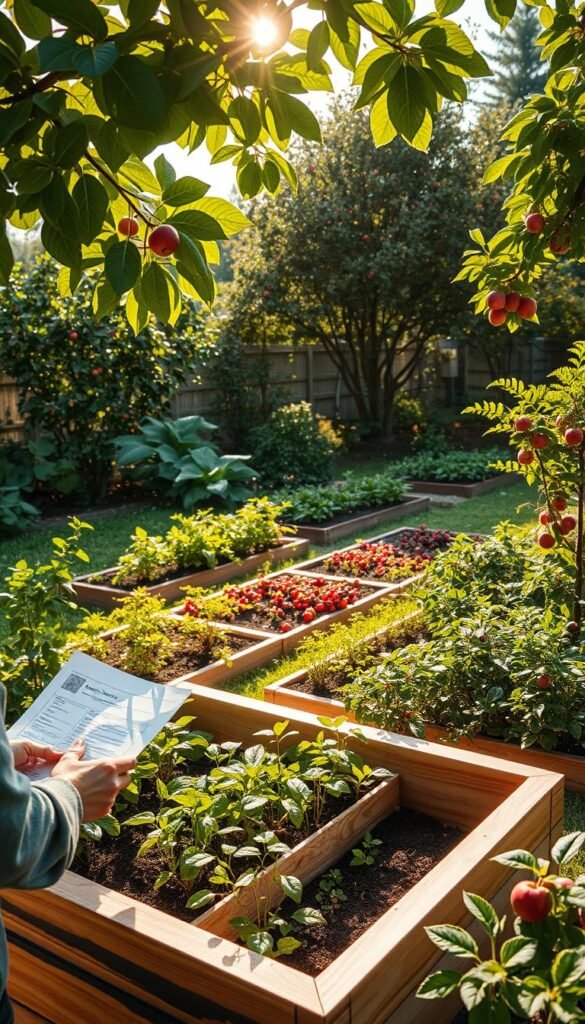
Your journey to fresh-picked goodness begins long before the first seed hits soil. Garden planning thrives as a continuous process, letting you refine ideas through every season. Whether sketching layouts in July or browsing catalogs in January, each moment offers chances to evolve your edible oasis.
Winter’s bare branches reveal your landscape’s hidden framework – the perfect time to assess paths, beds, and sun patterns. This clarity helps you spot opportunities: maybe a neglected corner could host raspberry canes, or patio containers might boost your blueberry yield. Jot notes about last year’s star performers and stubborn strugglers to guide new choices.
Digital tools become allies during frosty months. Bookmark dwarf citrus varieties for small spaces or explore succession planting strategies that keep harvests rolling. Did strawberries fade too quickly? Research everbearing types. Dreaming of figs? Check cold-hardy cultivars matching your zone.
Smart planners balance ambition with reality. Start with three reliable fruit plants, then add one experimental variety annually. Track sunlight shifts as trees mature, and leave room for future expansions. Remember: even the most detailed plans adapt as roots meet soil and seasons unfold.
Understanding Seasonal Changes in Your Garden

Decoding weather patterns unlocks extended harvests in challenging climates. In zone 5 regions like Ottawa, your fresh-eating months often outlast outdoor growing time by weeks. This gap pushes gardeners to work smarter with nature’s rhythms rather than against them.
Recognizing the Shifts in Weather and Light
Plants operate on sunlight and temperature cues you can learn to predict. Longer days in spring signal berries to flower, while cooling fall nights tell apple trees to sweeten their fruit. Track these patterns with a simple journal:
| Season | Daylight Change | Key Plant Response |
|---|---|---|
| Spring | +3 minutes/day | Bud break & bloom |
| Summer | Peak sunlight | Fruit development |
| Fall | -2.5 minutes/day | Root growth |
Notice how raspberries prioritize roots when daylight dips below 12 hours. This natural shift means fall is prime time for transplanting cane fruits. Fighting this cycle wastes energy – like pruning blueberries during bloom instead of dormancy.
Microclimates matter too. South-facing walls gain 10°F (5.5°C), letting figs ripen weeks earlier. Use these warm pockets for tender plants, saving open areas for cold-hardy varieties. When late frost threatens, cover peach blossoms with old sheets – simple protection that aligns with seasonal risks.
Spring: Preparing Your Garden for New Growth
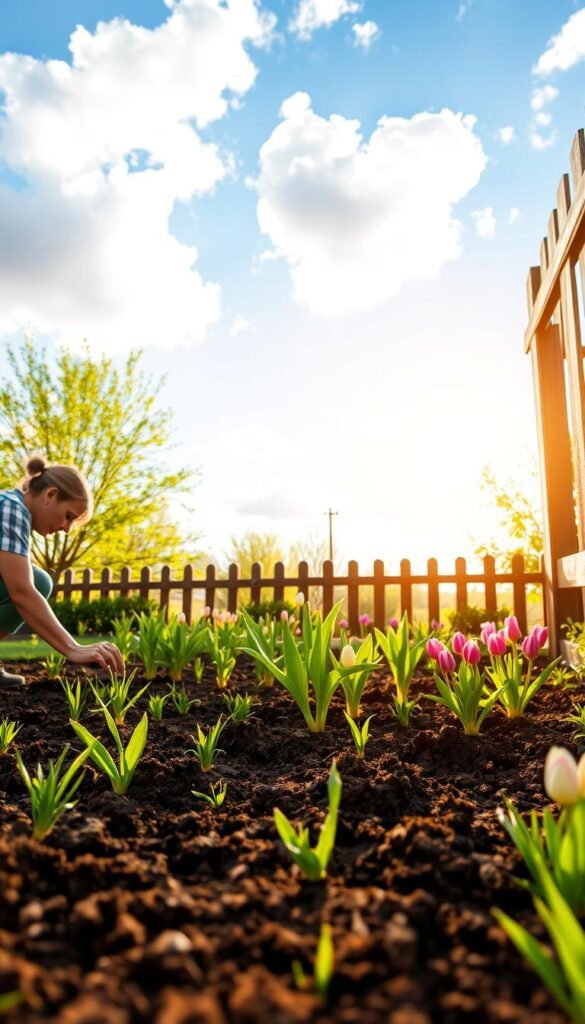
When soil temperatures nudge above 40°F, your green space awakens with possibilities. This season demands strategic action – balancing early plantings with careful groundwork for summer’s heat-loving varieties.
Soil Preparation and Seed Starting
Test your dirt’s readiness by squeezing a handful: if it crumbles instead of clumping, spring soil work can begin. In protected spaces like hoophouses, start turning beds in late February. Mix in compost while earth remains moist but not soggy – perfect conditions for cold-hardy seed germination.
Indoor sowing gives cole crops a head start. Try this schedule:
- Broccoli & cabbage: 6-8 weeks before last frost
- Kale & Swiss chard: 4 weeks pre-transplant
Planting Early Crops and Root Care
Follow spring planting rules for success: radishes and spinach go in when daytime highs reach 50°F. Protect young fruit tree roots by watering deeply once weekly – cold soils drain slower, so avoid drowning tender systems.
Master succession planting:
- Greens: Re-sow every 7-10 days
- Root veggies: Stagger plantings every 14 days
By mid-April, your garden should showcase pea shoots and beet greens. Reserve sunniest spots for upcoming tomatoes, but enrich those areas now with worm castings while beds are accessible.
Summer: Nurturing Your Garden for a Bountiful Harvest
Sunlight stretches long and bright as your edible oasis hits its stride. This season brings juicy rewards but demands smart strategies to keep plants thriving through heat waves and growth spurts.
Watering and Weed Control Techniques
Newly planted beans and corn need consistent moisture to establish roots. Water deeply before 10 AM to reduce evaporation, focusing on the soil rather than leaves. A simple schedule works best:
| Plant Type | Water Frequency | Depth Target |
|---|---|---|
| Seedlings | Daily | 1 inch |
| Mature Plants | Every 3 days | 6 inches |
Weeds compete fiercely for resources in summer. Spend 10 minutes daily pulling invaders or dedicate weekends to thorough sweeps. Mulch berry bushes with straw to suppress growth between rows.
Managing Heat and Sunlight Exposure
July’s heat tests even hardy plants. Shield raspberries with shade cloth during afternoon peaks. For fruit trees, wrap trunks with reflective tape to prevent sunscald. Follow these cooling tactics:
- Install temporary sun sails over delicate blueberry bushes
- Mulch root zones with 3 inches of wood chips
- Water stone fruits like peaches at dusk to prevent rapid drying
Time plantings wisely – potatoes sown by July 7th develop thick skins for winter storage. Check soil moisture daily when temperatures exceed 85°F, adjusting your routine as needed.
Fall: Transitioning with Season Extension Techniques
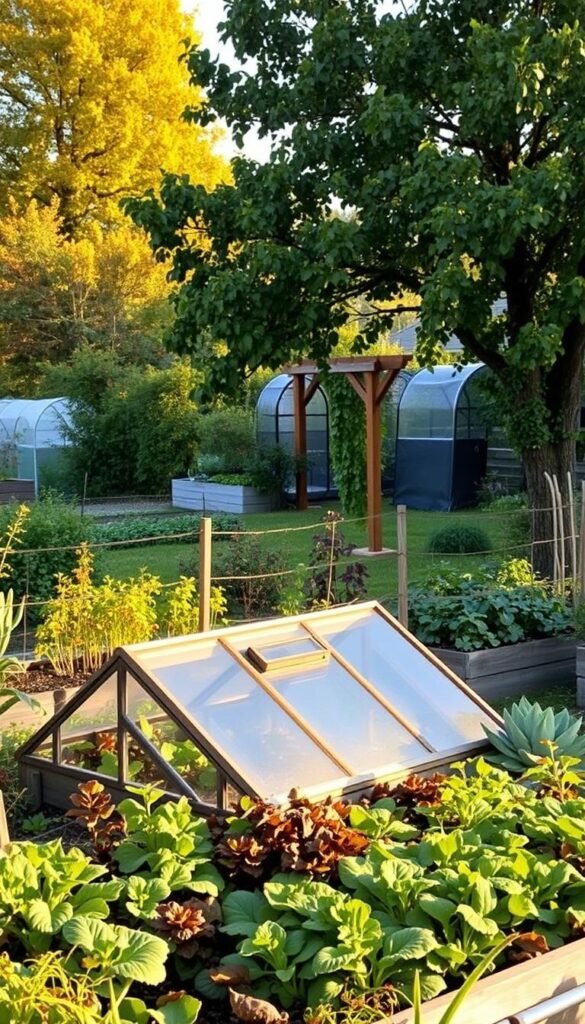
As autumn paints the landscape, your garden enters its final act – but the show isn’t over yet. This season rewards those who master protective strategies to squeeze extra weeks from their harvests. With smart timing and simple tools, you’ll keep fresh greens growing while neighbors pack up their tools.
Frost Protection and Row Cover Strategies
Watch weather apps like a hawk when temperatures approach 32°F. Tender crops like tomatoes and peppers need immediate harvesting before frost strikes. For hardier plants like kale or carrots, drape row covers directly over beds. These lightweight fabrics:
- Trap ground heat (up to 4°F warmer)
- Allow 85% light transmission
- Protect against light freezes
Secure edges with rocks or soil to prevent wind theft. Remove covers during sunny days to prevent overheating.
Implementing Cold Frames for Late Crops
Turn September into a second planting season with simple structures. A basic cold frame uses old windows and straw bales to create a microclimate. Plant spinach or arugula seeds in early fall, then:
- Water thoroughly at planting
- Close the lid on frosty nights
- Ventilate on sunny afternoons
This season extension technique lets you harvest leafy greens through December in zones 5-7. Pair cold frames with mulch blankets for even colder regions.
Pro tip: Mark your first average frost date on the calendar. Start protective measures 2 weeks earlier to avoid last-minute scrambles. Your plants will thank you with crisp, sweet late fall harvests that outlast summer’s bounty.
Winter: Caring for Your Garden’s Structure and Soil Health
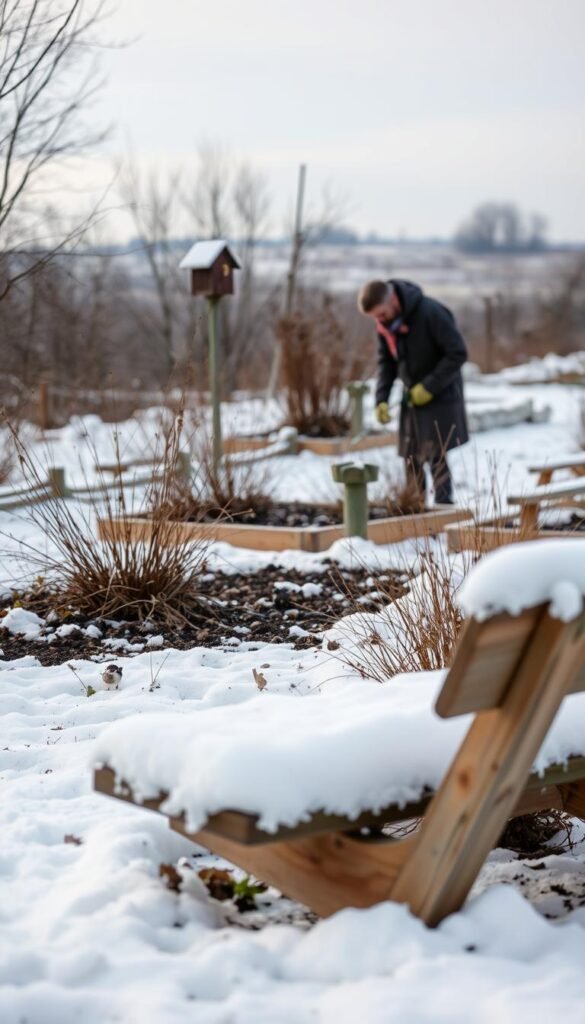
Winter’s quiet blanket signals time to fortify your garden’s foundation. As temperatures drop in late October and November, shift focus from growth to protection. Start by draining hoses completely – residual water expands when frozen, cracking equipment. Store irrigation tools in frost-free spaces like garages or sheds.
Your soil needs armor against winter’s chill. Spread 3-4 inches of straw mulch around berry bushes and fruit trees to insulate roots. Consider sowing winter rye in empty beds; this cover crop prevents erosion while adding organic matter come spring.
Check supports and structures while plants are dormant. Tighten loose trellis wires on raspberry canes and repair raised bed corners. These fixes prevent snowload disasters and save spring scrambling.
Use colder months to strategize next year’s bounty. Sketch new layouts, research disease-resistant varieties, and order seeds early. While your garden rests, you’re building the blueprint for another fruitful cycle – where every detail matters.

